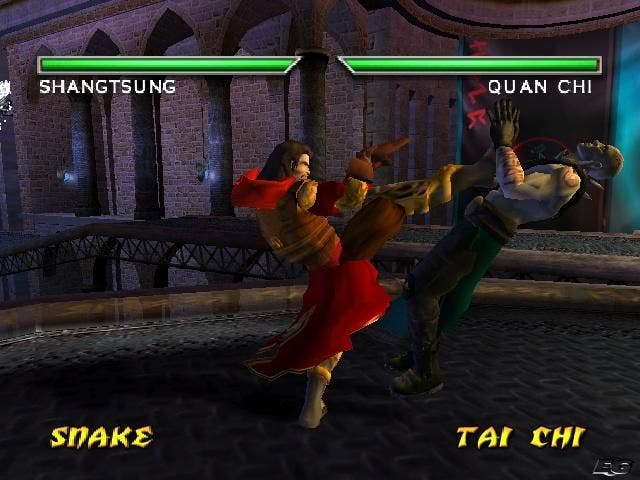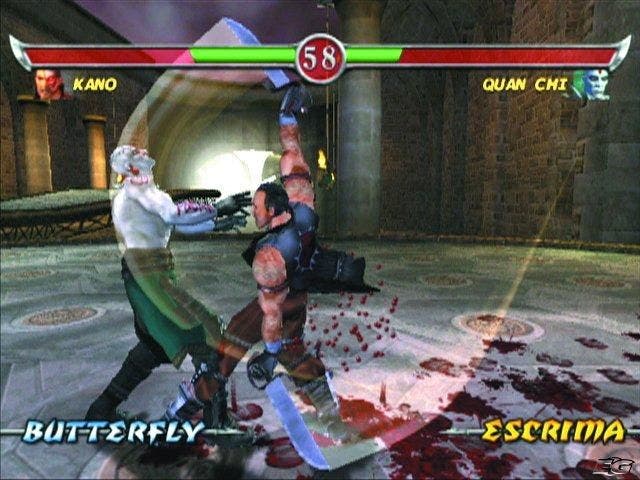Mortal Kombat: Deadly Alliance
Review - Kristan Kan't think of a Klever sub-head
We're not quite sure how this has happened, but in the past few weeks publishers have been queuing around the block to sell us our childhoods. Like some kind of mutant bible-bashing double-glazing salesmen, they hammer on the front door, demanding that we learn the ways of the next generation gaming experience. Mr Pac-Man appeared the other day, babbling phrases like "retro futurism", "adrenaline fuelled" and "insanely addictive" at us. The next day it was General Contra, brandishing a weapon in the vain hope of a respectable review score. But after the Defender incident with the bodysnatchers, we'd had enough and installed an intercom.
So when Bub and Bob knocked on the door we had great pleasure in laughing maniacally at their weak talk of spiny backed reinvention. Really? Are all the original ideas so bad, and so commercially unviable that rehashing an old hit is the only way to get gamers excited? Whatever the commercial reasoning, the fact is that most of the results of this passionless grave robbing are poor to say the least. On this basis, the 'revived' game is, for the most part, on to a loser before we've even got it out of the shrink wrap.

The ultimate gory beat 'em up?
But nagging at the back of our minds was the slim chance that the publisher and developer responsible actually have the resources and the talent to make its cash cow franchise even better in some significant fashion. At least in Mortal Kombat's favour, the 3D beat 'em up is a proven genre, thanks to Namco, Sega and Tecmo's sterling efforts over the years. With the obligatory next gen makeover, unlockable content and multiple game modes, how could it fail? Hmm, probably best we don't ask questions like that out loud, and instead tell you a bit about why grown men and women are acting so violently again.
Two evil "powerful sorcerers" Quan Chi and Shang Tsung have joined forces in a mwahahahaha-style quest for "supreme immortality", meaning it's your job via a character of your choice to show them who is, indeed, boss and kick their collective arses, thus restoring peace and harmony to the world - presumably until Midway decides its time to cash in on the franchise once again.
The game features the usual selection of game modes; Arcade, Versus, Practice and Konquest. The first three are self explanatory, while the latter gives players the opportunity to really get to grips with the intricacies of each of the game's characters, while earning plenty of 'Kurrency' in the process. It's well worth ignoring the Arcade mode for the first few hours of Deadly Alliance and just dive headlong into the Konquest levels, as not only does it strip away the initial mysteries of the control system, you'll come out of it a much better player as a result. Each character has ten challenges to perform, mainly consisting of simple 'press these three buttons' type tutorials, but gradually building up to complex combos which require extreme patience and repetition to crack.

Armed or unarmed - the choice is yours
To its credit, MKDA attempts to introduce a more comprehensive and strategic combat system than its many rivals. Each fighter has three distinct fighting styles to choose from at any time during bouts, selectable via the L1 button - one armed, and two unarmed fighting styles. Symbol buttons deal with the usual low/high kicks/punches, R2 blocks, while R1 delivers the very satisfying special moves. Meanwhile, an element of strategy comes into play in MKDA when fighters choose their armed fighting style; while they inflict more damage when armed, they also take more damage. It's often a fine balance to determine which one is more effective, and as such adds an enjoyable layer to the gameplay.
The combo system also feels somewhat different from the competition, thanks to its general tendency to rely more on quick presses of the buttons (for example, square, circle, triangle, L1, triangle and up) rather than the usual D-pad quarter turn/button mash mechanic of every bash 'em up since SFII. It's a tricky transition at first, and we're not convinced it feels as natural, but at least it feels like Midway is attempting something slightly different.
As you'd expect from this goriest of beat 'em up franchises, each character has its own unique Fatality move, giving you the ultimate finishing move - if you can work out how to pull it off, that is. Needless to say, these are as gruesome as you'd expect, with the highlight we've witnessed undoubtedly being the ability to rip the entire skeleton from your defeated opponent.
However, while the Fatalities are nicely implemented, the general level of gore present within the game is completely ham fisted by comparison. Each hit, however tame, nearly always results in a ridiculous splurge of ketchup that borders on farcical, and the lack of progressive damage to your opponent's torso is disappointing. We're sure Midway could have done better in this department, although maybe it steered away from realism in the belief that the censors would've had a hissy fit. Worse still comes when you floor an opponent in the traditional fashion (i.e. not a Fatality) - every single time they slump to the floor in the manner of a felled tree, no matter how impressive your death blow was, and if this happens near the predetermined edge of the arena, they mysterious judder forwards as if being pushed by an unseen force. While this is in keeping with how opponents collapse in every Mortal Kombat game ever, it just looks plain crap in a modern beat 'em up.

Wobbly jelly
The general visual quality also suffers in comparison to the majority of next gen beat 'em ups, being merely competent in virtually every single area, rather than pushing any boundary. Also the restrictive 'invisible wall syndrome' means characters are regularly colliding with artificial barriers at the edge of arenas, rather than spectacularly crashing through scenery and plummeting through multiple levels in the style of Dead Or Alive. The characters are, in the main, detailed and well animated, although what the hell is going on with the wobbly jelly animated breasts? Ew ew ew. While you may come away from MKDA reasonably satisfied about the way it looks, you'll hardly be ringing your mates up evangelising. Instead, you'll more likely be defending the game's lack of visual prowess, pointing out that it does have face saving innovation in the combat area.
But while the combat system does strike us as reasonably innovative - and quite interesting at first - the chances are you'll have to practise for a very long time for the combos to really become second nature. Even when you know what you're doing, the game demands such exact timing in terms of the intervals you're expected to press each button that it's often beyond frustrating. There's a very specific mid point between pressing the next button in the combo, and it's fair to say that it's exacting; press too soon, and the game just fails to register you've pressed it at all. Wait too long, and the wrong move will result, and you have to start the sequence of buttons over again. And when we say "wait too long" we're talking milliseconds, and frankly that kind of precision demands too much from all but the most committed beat 'em up fan. If that's you, then MKDA will no doubt present a great deal of enjoyment.
Plenty for your pains
Supposing you do have the stomach for the battle, then there's plenty to keep you going while we wait for the cold winter nights to politely go away. For a start, the Konquest mode features an epic 218 levels to fight through - although to be fair you'll blitz through most of them in a matter of seconds, so basic are the early challenges. For your pains, fortunately, the game rewards each successful bout in both Konquest and Arcade mode with Kurrency which you can spend in the Krypt opening up one of the 600 Koffins - each of which hold a mystery item, from the tedious 'Koncept' sketches, to more interesting extras such as extra characters and costumes (or Kostumes, presumably).
The game has already leaped into the nation's charts at No.3, and enjoyed a decent spell near the top of the US charts over Christmas. That tells us that the audience for the Mortal Kombat franchise is very much alive and well, but does that make it a good game? It's certainly not a bad game, by any means - it just never excels at anything it does to warrant its placing above any of the other contenders out there. It mixes it with the big boys in the early bouts, but it's never going to go the distance. We'd hold out for Soul Calibur II…
Mortal Kombat: Deadly Alliance screenshots (Cube)
Mortal Kombat: Deadly Alliance screenshots (Xbox)


